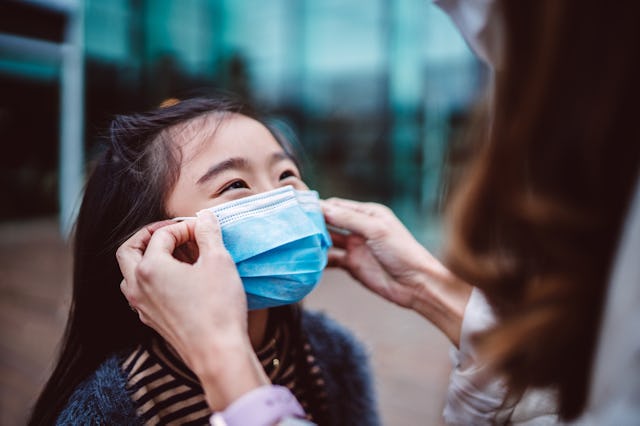With the BA.5 Omicron Subvariant Spiking, Should You Be Double Masking?
Two infectious disease doctors weigh in on this “extra” safeguard.

Now that we're well into yet another wave of COVID infections nationwide (this time fueled by the highly contagious BA.5 omicron subvariant), you're likely doing all you can to keep your family safe from catching it. Given that the Centers for Disease Control and Prevention (CDC) has not updated its mask guidelines since February — that is, before BA.5 made its way around the globe — it's understandable if you're confused about mask recommendations to best protect against BA.5 and future strains that might be just as transmissible. Whether you've already swapped cloth and surgical masks for an N95 respirator (or similar counterparts, the KF94s and KN95s), you might be wondering if it's beneficial to be double masking right now in an effort to reduce transmission as much as possible.
Scary Mommy got the scoop from two infectious disease doctors who shared their top masking tips for surviving BA.5… and whatever may come afterward.
The Dos and Don'ts of Double Masking
"There is evidence that wearing two masks improves particle filtration — meaning they could filter more and expose the wearer to less viral load," explains Dr. Joshua Schaffzin, MD, Ph.D., the director of infection prevention and control at Cincinnati Children's Hospital Medical Center. "As always, it comes with caveats: what type of masks, what order they are worn (cloth over the top of a medical procedure mask or under). The actual impact is hard to measure."
The most effective way to reduce viral load is by ensuring a secure fit no matter how many masks you choose, adds Dr. Zachary Hoy, pediatric infectious disease specialist at Pediatrix Nashville Pediatric Infectious Disease. "The CDC recommends a properly fitted mask, so if a good fit is guaranteed, then double masking is not necessary," he explains. "If there is a mask without a good fit, a disposable mask underneath a cloth mask on top can provide a better fit."
Snug, secure coverage of your nose and chin is essential, says Schaffzin: "The reason comfort and fit are so important is this: A safety tool used the wrong way will not be as safe as it could, and could be less safe. For example, seatbelts save lives, but only if used correctly. Not locking the belt in [and] not engaging the shoulder strap when seated in front may help more than not having one at all, but that won't keep you as safe as a belt used properly. This is why the CDC recommends against using masks with exhalation valves or vents. Also, wearing a mask that has gaps on the sides or that does not cover both your nose and chin will not work as well as one that fits well — and it may not work at all."
Current Health Guidelines for Double Masking
As mentioned, Schaffzin notes that neither the CDC nor World Health Organization currently recommends double masking, adding, "The CDC emphasizes comfort and fit in its guidance, which I think is very important to consider. It's less about the number of masks, or even the type of mask, and more about comfort while wearing whatever mask is chosen. If anyone is uncomfortable or feels short of breath while wearing two masks or a specific type of mask, they should make a different choice."
That said, BA.5 is still so new, notes Schaffzin, with both doctors adding that if double masking provides a more secure — yet still comfortable — fit than a poorly-fitting single mask, it's not a bad idea to double up.
"One other consideration for families and children is balancing effective tools with the best (or most effective) tools," says Schaffzin. "It's true that an N95 respirator will filter more than a cloth or medical procedure mask, but is it really necessary? If medical procedure masks combined with vaccination and good hand hygiene provide protection and are more comfortable to fit and wear for long periods, they are a fantastic, effective tool."
"Wearing a mask that won't work properly is probably not much better than not wearing a mask at all," he adds. "Wearing one shoe in the rain will keep part of you dry, but not enough to make you comfortable (and dry)."
Masks Do Work When Used Properly
No matter how you slice it, a well-fitting mask worn in public or around those who are sick is a solid way to prevent transmission not just of COVID but of other viral illnesses. Says Schaffzin, "We have learned from COVID that masks work. We could not say that before COVID, and we did not see masks as an effective tool for protection from other respiratory viruses like the flu. That needs to change for all of us, and we need to use masks to protect us from respiratory viruses when the risk of transmission is high, such as during flu season."
The TL;DR here, per Schaffzin: "One well-fitting mask is much better than no mask, and should provide adequate protection. Making sure they are properly made, fit well, and are comfortable — and adding the extra protection from hand hygiene and vaccination — will help keep all of us safe."
Expert Sources:
Dr. Joshua Schaffzin, MD, Ph.D., the director of infection prevention and control at Cincinnati Children's Hospital Medical Center
Dr. Zachary Hoy, pediatric infectious disease specialist at Pediatrix Nashville Pediatric Infectious Disease